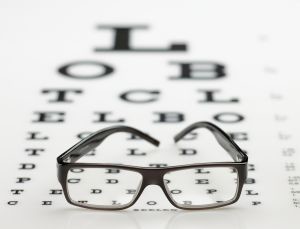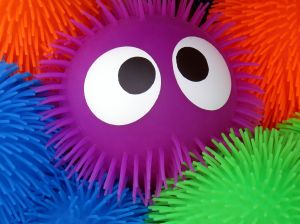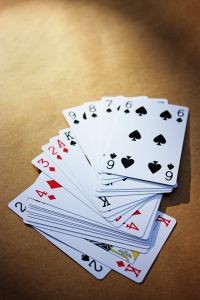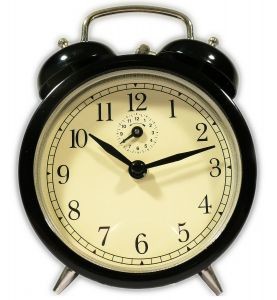By Craig Valency, MA, CSCS
Introduction
As I discussed in my introductory post, the missing link to true movement mastery is learning the 9 perceptual-motor skills as early as possible.
As fitness professionals, teachers, therapists, or parents, we have a unique opportunity to even the playing field by offering every child we work with an ideal environment to explore movement through all their senses.
These skills lay the foundation for an increased movement vocabulary with overall better coordination and the ability to learn the fundamental movement skills. With this foundation firmly in place, children are better equipped and more likely to engage in sports and recreational activities for a lifetime.
Here is a bird’s eye view of the 9 perceptual-motor skills we’re looking at in this series:
- Body: Understand the parts of the bodies and how they move
- Directional: Differentiate between the left and right sides of the body and move in all planes of motion
- Spatial: Has a sense of how much space one’s body takes up and moves comfortably around other people and objects
- Temporal: Has a sense of timing and rhythm
- Visual: Can visually focus and track objects
- Vestibular: Develop an internal sense of their body’s position in relation to gravity
- Auditory: Can accurately respond to sound
- Tactile: Can respond to touch in competitive situations to counter a move, as in wrestling, or in cooperative situations to stay with a partner, as in dance
- Proprioceptive: Interpret the internal sense of where the body is in space
Today, I’ll focus on visual awareness and discuss why it is so important to overall coordination, movement efficiency, and even improved reading skills and overall learning and comprehension! I’ll outline what it is and give specific ideas that you can use to teach visual awareness in any youth fitness program.
What is visual awareness?
Visual awareness refers to the ability to:
- Focus or fixate on a target
- Quickly and accurately switch focus to various targets
- Smoothly track and follow objects of various sizes and at varying speeds
- Maintain a central focus and take in images or movements on the sides, known as peripheral vision
- React quickly and smoothly to visual signals
Poor visual awareness skills are often the culprit when a child seems uncoordinated and always “strikes out,” or when a child struggles with reading fluency and comprehension.
Being able to focus or concentrate on an object or person for an extended period of time or track objects without distraction, such as a tracking the ball while playing tennis, translates directly to better eye-hand or eye-foot coordination. 
The ability to properly track words on a page or screen helps to avoid skipping words or lines, or mixing up letters (as is seen with dyslexia). Consequently, it improves reading skills and comprehension.
Eye Development in Kids
Until about 6 years of age, the macula of the retina is not fully developed; so younger children are functionally farsighted and largely unable to properly fixate and intercept moving objects (Gallahue, p. 31). The eyeball achieves its normal round shape between the ages of 6 to 9 years old, at which point the eye can more effectively track and follow moving objects. Still, the neural connections to the brain are not yet fully matured, so judging distance and direction may still be difficult.
 This means that a typical child between the ages of 6 and 9 can judge the speed of a ball being thrown, but not necessarily its direction. Children in this age range can more easily hit or catch a ball that is thrown directly to them, but they often have difficulty figuring out where to go and how fast to get there (Stricker, p. 46).
This means that a typical child between the ages of 6 and 9 can judge the speed of a ball being thrown, but not necessarily its direction. Children in this age range can more easily hit or catch a ball that is thrown directly to them, but they often have difficulty figuring out where to go and how fast to get there (Stricker, p. 46).
As with any other form of training, however, children can adapt and progress at a faster rate by regularly doing targeted visual awareness drills. These exercises lead to better overall eye-hand and eye-foot coordination at a younger age. In fact, I believe that earlier adaptation and improvements in visual skills would naturally occur if kids played outdoors as much as they used to.
The Alarming Rise of Nearsightedness in Today’s Kids
My brother and I have worn glasses since childhood; without them, we are legally blind. Both of our parents had perfect vision and never wore glasses. I’ve always thought that was curious. As I saw more and more kids wearing coke bottle lenses, I wondered how any of us would have survived in prehistoric times. I suspect most of us would have been lunch for a hungry sabre-tooth tiger!
This seeming contradiction began to make more sense when I learned about the incredible rise in myopia in just the last few decades. In the U.S. alone, rates of myopia have jumped 65% since 1970! (Dongmei Cui, Klaus Trier, Søren Munk Ribel-Madsen, 2013). In Asia it’s even worse, as a recent 2015 study showed 80% of teenagers surveyed in Beijing, China had myopia. A 2012 study in Seoul, South Korea revealed that nearly all teenagers surveyed (24,000) had myopia (Wall Street Journal).
Multiple studies suggest that the sudden rise in nearsightedness can be attributed to too much close-up work, such as reading and working on electronic gadgets, as well as a lack of natural sunlight on the eyes.
A 2009 randomized control trial of over 300 students in Taiwan looked at the effect of implementing 80 minutes of daily outdoor recess for one year and the rates of developing myopia. A significantly larger number of those in the control group became nearsighted or approached nearsightedness compared to the group that received daily outdoor recess. (Dongmei Cui, et al., 2013)
Visual Awareness and Other Perceptual-Motor Skills
There’s a lot of crossover between vision and the other awareness skills. For instance, temporal awareness, or good timing, along with good visual tracking, is intimately involved with catching or hitting a moving target.
The vestibular system of the inner ear, which is responsible for balance, is also responsible for the vestibulo-ocular reflex (VOR). The VOR stabilizes the eyes whenever the head moves. For example, when the head moves left or right, the eyes move in the opposite direction; images are stabilized on the retina, allowing the person to focus on an object or person while the head is moving. Think of doll’s head, moving side to side. The eyes always look straight ahead. Many of the eye tracking activities I’ll talk introduce in just a moment are designed to stimulate increased communication between the inner ear and the eye.
Visual Awareness In Relation to Balance
Vision is the most dominant sense utilized in postural control and balance. Visual dominace begins in infancy. It develops before the proprioceptive, internal body sense, or the vestibular systems of the inner ear. Vision dominance is a leading factor utilized in most motor skills, accounting for up to 80% of sensory feedback related to movement (Gambetta, 2007, p. 148).
Teaching Visual Awareness
You can start teaching visual awareness by acknowledging and pointing out the visual cues that exist in a child’s world. Next, specifically practice fixating and concentrating on one particular target before working on the various tracking drills and, finally, progressing to more advanced peripheral vision drills. It is also a good idea to start many of the drills using only one eye at a time before integrating both eyes together.
Here are some fun ways to bring visual awareness to life with kids:
- Daily visual awareness questions – Start teaching visual awareness by calling attention to the visual cues that are all around them. Challenge kids to be more aware of what is going on in their world and the implications of those visual cues. Here are some daily visual awareness homework questions to get them going:
- Are there rain clouds far away on the horizon? Can you tell how windy it is by looking at trees and branches? In what direction are the trees and branches being blown by the wind? See how many different kinds of bugs you can find on one bush, tree, or plant. How many different kinds of flying animals can you spot as you look in the sky for 2 to 3 minutes? Look for a bird, butterfly, fly, or bee; and follow one with your eyes for as long as you can.

- And finally, challenge kids to get outside more and look at the most far away things they can see. Prompt them to look in all directions: left, right, up, and down. This will help them relax their eye muscles from the strain of focusing on close-up materials such as schoolbooks, phones, iPads, or the TV.
- Are there rain clouds far away on the horizon? Can you tell how windy it is by looking at trees and branches? In what direction are the trees and branches being blown by the wind? See how many different kinds of bugs you can find on one bush, tree, or plant. How many different kinds of flying animals can you spot as you look in the sky for 2 to 3 minutes? Look for a bird, butterfly, fly, or bee; and follow one with your eyes for as long as you can.
- Fixation & concentration – These drills help kids improve concentration and the ability to keep the eyes focused on a target for an extended period.
- Focus & Move: Have kids focus on one thing while they do various movement skills. This works on maintaining visual focus in a realistic setting, such as a game or sport, where they have to watch their opponent, teammate, or ball while executing a movement skill. While one partner holds a tennis ball, she can call out various movements for the other partner to do. Her job is to make sure that her partner keeps his eyes fixated on the ball the entire time. Another option is for the teacher, trainer, or coach to call out the same move for the whole class, while one partner watches to see that focus is maintained until it is her turn. Here are some movement ideas they can do while focusing on the ball:
- Squats, lunges, torso rotations, skater plyos, sit to stand, jumps, hops, march in place, skip in place
- Agility ladder number calls: Line the students up at the agility ladder. Put one child on the opposite end of the ladder. This child holds up numbers on her fingers. The first child in line runs through the agility ladder while calling out the numbers he sees. When he gets to the end of the ladder, he takes over and holds up fingers for the next student. The next child in line goes through the ladder.
- Head rockers! – Kids are partnered up with one holding a ball at head level. The partner should focus on the ball and move his head side to side, then up and down, diagonally, and finally in circles, never losing sight of the ball. The partner holding the ball should call out directions. This drill helps with the communication between the vestibular system and eyes. It also improves directional awareness and auditory awareness.
- Visual tracking (smooth pursuit) – “Keep your eye on the ball!” These drills help with smoothly following objects from start to finish. This will improve eye-hand or eye-foot coordination and being able to intercept a ball or other object. It also helps with tracking words on a page, allowing for improved reading fluency and comprehension abilities.
- Partner pursuits: Kids are partnered up, with one partner holding a ball at head level. The partner holding the ball should move it side to side, then up and down, diagonally, and finally in circles. The other partner should keep the head still and only move the eyes, never losing sight of the ball.
- Variations:
- Use one eye at a time
- Start with small movements then use larger movements
- Vary the speed
- Stand on one leg
- Variations:
- Partner track n’ trap: Partners should be positioned on hands and knees (crawl position) 8 to 10 feet apart. One partner rolls a ball to the other, who must track the ball and stop it by trapping the ball with one hand before it can get past him. These drills also work on timing, which is a form of temporal awareness.
- Variations:
- Both partners can be in a bear crawl position with knees off the ground
- Both partners could be in a plank position (hands or forearms)
- Use various size balls (smaller, harder balls are more challenging)
- One child is standing and must stop the ball with his foot and return it by kicking it while his partner is in the crawl position and stops it and rolls it back with his hand
- Variations:
- Card tracking: Use a standard deck of cards and toss them up one at a time; have kids track them visually. The cards will float in unpredictable patterns, forcing kids to focus more intently to keep track of the cards.

- Variations:
- Bubbles: Blow bubbles for younger kids to practice eye tracking with slower moving, yet still unpredictable patterns. Then have them try and grab or flick the bubbles to link temporal awareness with visual tracking skills.
- Scarves: The same can be done with various colored scarves, which move slowly, but in unpredictable patterns. Throw a variety of scarves up and ask them to pick out a specific color and track it until it falls to the ground.
- Card catch: Have kids track the cards and try to catch them. Use both hands at first; then require only the right or left. The kids can stand shoulder to shoulder facing you and sprint to you when their respective names are called; or you could go to each one of them and toss a card in front of them. They each get 2 chances. If they miss both, they sit down. The last one standing wins.
- Circle popcorn catch: Have kids stand in a large circle and rapidly toss up cards. Any child may attempt to catch the cards. As a child catches a card, she must run 5 yards out from the circle and place it on a spot marked with her name, then sprint back and continue catching cards. When all the cards are gone, the child with the most cards wins.
- Variations:
- Visual tracking Saccades (“eye jumps”)– This is the ability of the eyes to quickly and accurately jump from one object to the other. This is important for being able to keep track of multiple opponents or teammates in a sport or activity. This is also a critical skill to effectively read and comprehend texts, as the eyes have to properly “jump” from word to word and line to line without losing their place.

- Clock eyes: This can be a whole class activity where all the kids are told that they are looking at the center of really big clock (think Hunger Games: Catching Fire). Randomly call out times and instruct them to quickly look at that number, then return back to the center until the next time is called out.
- Near & far: This is another whole class activity. Have the kids hold up one hand with their thumbs up. They should be staring at their thumbs until you call out an object ahead that is as far away as possible. They must search and locate and object and quickly shift focus from near to far then immediately return their gaze to the thumb.
- Reaction to visual signals – These drills work on being able to quickly change directions based on a visual signal. This requires significant visual focus while moving, as well as directional awareness to properly move in the right direction. This agility drill integrates the ability to fixate, concentrate and track in a reactive sports specific setting.
- Agility ladder sprints – Have one child positioned at the end of the ladder as the “pointer.” As another child runs through the ladder, the “pointer” randomly holds up either the left hand or the right hand; the runner must exit the ladder on that side, sprint past the pointer, and give him a high five. Now he becomes the pointer for the next runner.
- Lateral shuffle & roll reaction – Have the kids start in an athletic stance and lateral shuffle to the direction that you point. If you point down, they must log roll in the opposite direction they were shuffling. Continue to point left and right and they must shift their rolling to that direction. When you point up, they must pop up and shuffle in the opposite direction they were rolling.
- Peripheral vision: This can be tough to master, as kids have to focus straight ahead while taking in as much as possible of what is going on around them − without looking around. This awareness will help reduce “tunnel vision” and keep them aware of what is going on in their entire field of vision. This skill will help with most team sports, as well as activities of daily living such as crossing the street and being aware of traffic dangers.
- Partner periphery – Kids are partnered up and one should fixate on their partner’s nose. The other should keep her hands at head height and slowly move them out to the sides, making sure that her partner keeps focusing straight ahead. At that point, she can start holding up fingers. The partner who is looking at her nose should call out the number of fingers on each hand or add (multiply, subtract, etc.) the numbers from both hands. If the child can’t see the hands at all, make sure the other child slightly brings them in closer until they can be seen them without moving the eyes or head.
Conclusion
The key to teaching visual awareness to children is to create an understanding of the visual world that exists all around and the importance of being aware of visual cues and their consequences. Next, help kids learn to focus on one target for an extended period of time. Introduce visual tracking exercises for smooth pursuit of an object, as well as to jump form one object to another (saccades). Once kids master the basics of visual focus, smooth pursuits, and saccades, introduce them to reactive movement drills with visual signals. The toughest task is improving peripheral vision. All of these drills will not only improve eye-hand and eye-foot coordination, but they will also improve skills in the classroom – especially reading fluency and comprehension. When kids have better visual skills, along with an increased awareness of the importance of understanding the visual world around them, the result will be smoother, more coordinated children who can navigate the court, field, book, or street more safely and efficiently.
In part 7, I’ll talk about vestibular awareness, which refers to the semi-circular canals of the inner ear that are responsible for helping maintain postural stability, balance, and visual focus.
References
American Academy of Ophthalmology. “More time outdoors may reduce kids’ risk for nearsightedness, research suggests.” ScienceDaily. ScienceDaily, 26 October 2011. <www.sciencedaily.com/releases/2011/10/111024084639.htm>.
Bowman, K. (2014). It’s hard to rest in a zoo: Release the eyes. In Move your DNA (pp. 144-149). Propriometrics Press.
Denner, K. (2013, July 10). Vestibular disorders association: Vestibular ocular reflex (VOR) exercises. Retrieved from https://vestibular.org/news/07-10-2013/vestibular-ocular-reflex-vor-exercises
Dongmei Cui, Klaus Trier, Søren Munk Ribel-Madsen. Effect of Day Length on Eye Growth, Myopia Progression, and Change of Corneal Power in Myopic Children. Ophthalmology, 2013; 120 (5): 1074 DOI: 10.1016/j.ophtha.2012.10.022
Eye can learn: Eye exercises for visual health and school success. Retrieved from https://www.eyecanlearn.com/tracking/
Gallahue, D., & Cleland Donnelly, F. (2003). Developmental Physical education for all children (Fourth ed.). Champaign, Illinois: Human Kinetics.
Gambetta, V. (2007). Movement aptitude and balance. In Athletic development: The art & science of functional sports conditioning (pp. 145-149). Champaign, IL: Human Kinetics.
Stricker, MD, P. R. (2006). Sports success Rx: Your child’s prescription for the best experience.
Wang, S. S. (2015, April 20). The puzzling rise in nearsighted children. The Wall Street Journal.
Craig Valency, MA, CSCS, president and co-founder of SPIDERfit, has been a personal trainer for the last 11 years. He is currently working at Fitness Quest 10 in San Diego, an elite personal training and athletic conditioning facility. He specializes in youth strength and conditioning programs that promote physical literacy, injury prevention and optimal performance. Along with training youths from 6 to 18 years of age for general fitness, Craig has also worked with some of the top junior tennis players in the world. He has been a physical education consultant for the Stevens Point school district in Wisconsin for the last 3 years, helping revamp the district wide programming for the K-12 PE curriculum. Craig earned his bachelor degree from UCLA, and Masters Degree in Kinesiology from San Diego State University.








Connect with SPIDERfit!